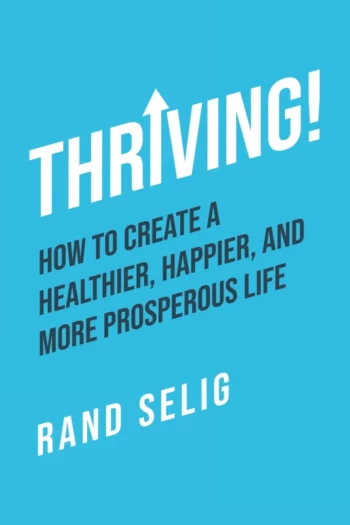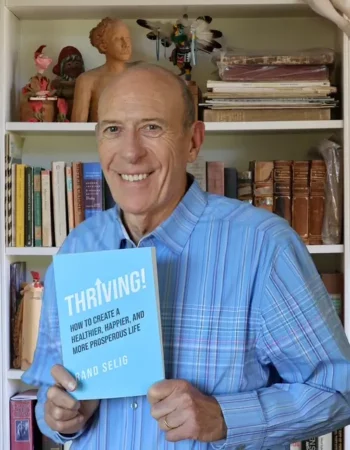
A Practical Guide to Living Better—Rand Selig’s Quiet Masterclass
By Jim Nowakowski (special to kb-resource.com)
In a world full of noise, Selig’s work stands out for its calm insistence that knowing yourself is both the hardest task and the most necessary one.
_____________________________________________
There are over 15,000 self-help books published in the U.S. each year according to the Harvard Crimson. That sounds like a lot of us need help if that number is true year over year, doesn’t it?
But there’s only so much time, isn’t there? Who can read 15,000 books? After all, if you are reading, you are not doing, and if you are doing, you are not reading.
Aside from the classics like How to Win Friends and Influence People, the 1936 self-help book by Dale Carnegie, every now and then one of the 15,000 books bubbles up to the top and stands out — one that seems to offer all of us (especially in the busy design community) some life-lessons to encourage our commitments to our profession and to ourselves.
 Thriving! How to Create a Healthier Happier and More Prosperous Life by Rand Selig is such a book.
Thriving! How to Create a Healthier Happier and More Prosperous Life by Rand Selig is such a book.
It’s one of those books that you read a little, think a little about, do your work, read a little more, think a little about, do your work. Wash, rinse, repeat. For busy people, it’s perfect. And it works because Selig is a facilitator – not a preacher. He doesn’t have a “proven formula.” Instead, he uses his own life experiences to give you quiet suggestions on shaping your own life…your business…you.
He trusts himself with us, revealing portions of his life that shaped him. He tells you upfront: “this book is about making choices and creating habits that help us get more good cards than bad, and playing the cards we’re dealt in life with as much choice, courage, and positive outcome as possible.”
And he means it, because if you know anything about playing cards, you have to learn to play the cards you’re dealt; no amount of wishing, hoping is going to change your cards (I mean, you can always fold, but as Selig explains, thriving is not about folding!).
“Thriving happens when the frequency of positive is vastly greater than the frequency of negative,” is how he puts it. Which reminded me of the game of chess.
You see, in chess, every move you make you gain something and lose something. The object is to gain more than you lose with each move until you are in a position to attack and checkmate the opponent’s king.
In life, as Selig describes it, it’s the same thing: making moves on your self, the people around you, the world and life itself that puts you in a position to be at one with yourself, with the people around you, the world and eventually life itself.
Which is easier said than done.
But Selig has obviously been through the gauntlet of introspection (which is the core of thriving), and because of that, serves as our guide for those going through it or those seeking to go through it.
Introspection
The book is conveniently divided into four sections: Thriving Personally, Thriving Together, Thriving in the World, and Thriving by Moving Ever Forward. It’s not an accident that the longest section representing over half of the book is the first one: Thriving Personally.
Why is that?
When you fly an airline, the instructions before takeoff are always the same: if something goes south, put your oxygen mask on first before helping others. The reason is obvious: you can’t help others if you can’t breathe.
The essence of introspection is just that: learning about yourself before you learn about others. Because when that happens, you thrive! In 131 pages, Selig helps you in this most difficult tasks: to know who we are, we have to become self aware. We have to look at ourselves honestly, relentlessly.
If you’ve done introspection, or you know someone who has, introspection isn’t easy. In fact, introspection is probably the most difficult thing a person will ever do — if they do it at all.
Why doesn’t everyone do it? Because admitting yourself to yourself is messy (who wants to admit they are a jerk). Which is why it’s nice to have a guide like Selig to help with the pain of knowing yourself.
Because once you do introspection, you do it for the rest of your life. And because you do, you can then help others, the world, and you thrive.
Socrates said it first and best: know thyself. Reading Thriving! is like having a Socrates next to you to help through the journey of your self.
The Greek myth that mirrors introspection best is Sisyphus. Sisyphus was punished for tricking the gods. He was condemned to roll a rock up the hill, but just before reaching the top, it rolled back down. He goes back down, rolls it up, it rolls back down. Wash, rinse, repeat. Forever. Can you imagine a more absurd task?
But the key to understanding the myth in terms of introspection (what the existentialists realized) is that it’s not getting to the top that is important: it’s rolling the rock. The pleasure of work, of learning, of thriving (if you are not rolling a rock, you’re not thriving).
Selig’s book helps you roll your rock. The book is really a never-ending set of thoughts, challenges and wisdoms that comes from a man who knows, who has been rolling his rock for a long time.
Selig peppers his content to help us with ours using quotes, 118 footnotes, book references, and many questions, tests, checklists. He even brings in a comprehensive reading list of 80 books that helped him discover who he really is. They are all there for us to pick up or ignore; like I said, Selig is comfortable enough with himself to have us make those choices on our own — no force feeding of advice, just conversation and encouragement.
We are rewarded with remarkable discoveries as a result.
For example, he notes: “when we take responsibility, we have the ability to choose how to respond to what’s going on rather than feel the compulsion to react. To be successful and thrive, we need to be responsible people.” Sounds simple enough, until you think about it when he challenges you with responsibility questions (i.e., What values are you living?).
Or when he writes: “When we make a mistake, we become stronger by reviewing how it happened and what we could have done differently.” And then asks: “What mistakes have you made? Be honest. Write them down. What did you learn from them?”
The Japanese call this idea Kaizen, the philosophy of continuous improvement. You make a mistake, stop everything and fix it. But Selig uses Kaizen on your self — to be practiced on your own self. Kaizen it turns out is introspection! And the result when you do figure it out? You Thrive!
Duke Ellington once said, “A problem is a chance to show your best.” And that’s what Thriving! is about: solving the problem of yourself, and how you relate to yourself, and to others.
Selig issues ongoing challenges: “Have you ever worked with someone who felt they were smarter than everyone else? What did you do? How did it work out?”
I learned that lesson years ago and would have answered his question this way: “You can’t tell someone who knows everything, anything, so keep quiet, listen and just give them what they want.”
In fact, the basic question Selig asks in Section One and tries to guide you to an answer is, who are you? It’s the same question that the caterpillar asked Alice in Wonderland if you recall. And as Selig points out, it’s an ongoing series of answers because we all change – and sometimes, not for the better! (Remember how often Alice changed!).
Money, Money
His chapter on money is one of the most engaging, especially when he explores the concept of “enoughness.” That is, how much money is enough? William Blake the great English poet said: “You never know what’s enough until you know what’s more than enough.” That is a dangerous but true premise, especially if you lift weights or test your own limits. Selig helps you cope with it.
He explains “enoughness” successfully because Selig is a giver, not a taker, and he realized in his life that money is just how you keep score, a means to an end. “For me personally, I am happiest when I am ‘invisible,’ when I am not focusing on myself but on another person or a project I am committed to. I also find great pleasure in a hard day of honest physical work.” How do you thrive?
For busy people like designers, Selig’s Thriving! is one of those books you can dip into as time permits – a life workbook as he himself suggests to help guide us through the journey of living and working.
Herman Hesse, in his book Steppenwolf, wrote: “You may develop the game of your life and lend it animation. You may complicate and enrich it as you please. It lies in your hands.”
And that’s exactly Selig’s point in Thriving! The game of our life is in our hands. The good news is, we can also put his book in our hands, too, to help the development.
(Jim Nowakowski can be contacted at: [email protected]).